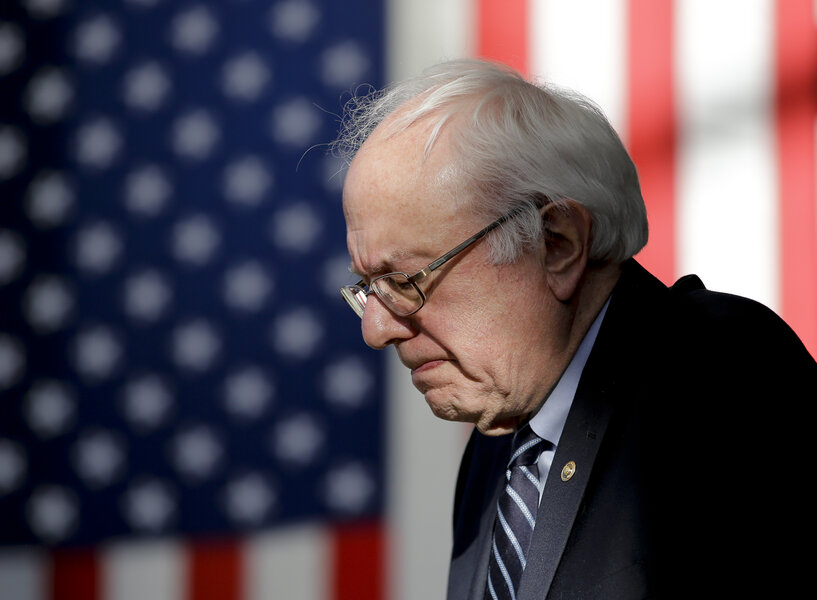Why Bernie Sanders's revolution is not showing up
Loading...
Bernie Sanders talks a lot about inspiring a political revolution. That’s how he’ll get Medicare-for-all and other progressive policies enacted over Republican objections, he says: a new army of left-leaning Sanders voters will rise up and overwhelm the status quo.
An expanded electorate is an implicit part of this vision. That’s what it would take for Democrats to break into the GOP’s red state congressional strongholds, retake the House, and build up a filibuster-proof Senate majority.
Well, that aspect of the revolution isn’t happening. At least, not yet. Turnout was down in all the Democratic votes held so far. That’s a big reason why Hillary Clinton, with her more utilitarian message of incremental change and the importance of experience, has dominated the Democratic race.
Sanders (I) of Vermont admitted as much on Sunday during an appearance on NBC’s “Meet the Press.” “I wish we had had a larger turnout,” he said, referring to the Nevada caucuses in particular.
The last time the Democratic Party had a contested primary season, in 2008, Nevada caucus turnout was about 118,000. This time around it was closer to 80,000. That’s a drop of about 33 percent.
In New Hampshire, about 288,000 people participated in the Democratic primary in 2008, while roughly 251,000 turned out this year, according to figures compiled by Steve Benen for MSNBC’s left-leaning Maddow Blog. That’s shrinkage of 13 percent or so.
In Iowa, Democratic caucus participation went from 236,000 in 2008 to about 171,000 this year, for a 25 percent reduction.
This pattern should be alarming to Sanders supporters. “His entire candidacy is built on the premise that he, and he alone, can boost turnout in ways pundits and the political establishment fail to appreciate," writes Mr. Benen.
What are the larger political lessons here? One is an old advance person’s truism: crowd size is deceiving. Huge and enthusiastic rally audiences have convinced many candidates that they were building momentum when they weren’t. Sanders may not be different in this regard.
Another is that it is risky to depend on young voters. They don’t vote in the percentages that their elders do. Maybe they have more to do; maybe their schedules are more unpredictable; maybe they’re just feckless (kidding!).
Sanders destroys Mrs. Clinton among younger voters, winning upwards of 80 percent of their votes, or more. But voters under age 30 underperformed in all three states that have now voted, in the sense that they made up a smaller share of those who turned up at the polls than they comprise of the state’s population.
Voters over age 65, who disproportionately back Clinton, did the opposite, and over performed.
“This is why campaigns that need younger voters in order to win often don’t,” writes The Washington Post’s expert poll analyst, Phillip Bump.
The sharp-eyed may have noticed a flaw in the ointment of the analysis above: Sanders did not lose all those states. He won New Hampshire by 22 percentage points. How could that be?
Well, turnout among under-30 voters in New Hampshire was only down by a hair. That’s one reason.
Another reason – and a big one – is that the Democratic Party is more liberal than it used to be. The whole organization has lurched towards the ideological pole where Sanders has always stood.
One-third of New Hampshire voters described themselves as “very liberal,” according to exit polls. Sanders won a whopping 67 percent of their voters. Another 42 percent said they were “somewhat liberal.” Sanders won 57 percent of them.
In Nevada, 70 percent of Democrats who caucused said they were liberal. The corresponding figure from 2008 was only 45 percent.
The bottom line: this means lower turnout doesn’t doom Sanders. But it makes his climb much steeper. And for the “revolution” part – Sanders is probably right that it would require a flood of new progressive voters to build the majorities necessary to pass his proposals. If they don’t arise, neither will free college.







